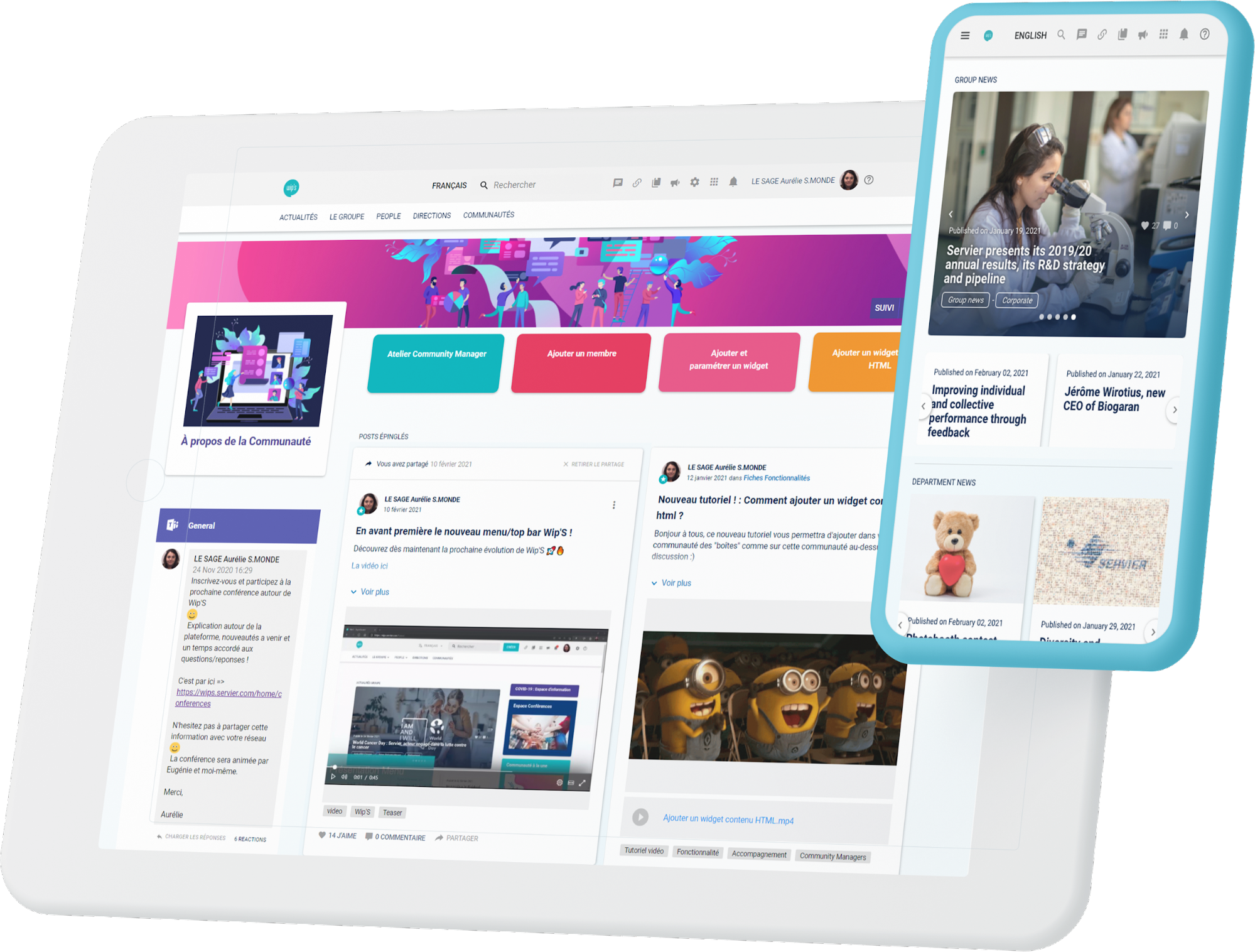

What is an Employee Intranet and why should I get one?
In today's modern business landscape, effective communication, seamless collaboration, and engaged employees are crucial for a company's success. This is where an employee intranet comes into play.
An intranet is a powerful platform that fosters internal communication, promotes collaboration, and enhances the overall employee experience. We'll delve into the concept of an employee intranet, explore its benefits, and provide insights into building an effective hub to transform your business operations.
What is an employee intranet?
An employee intranet is a private internal website or digital workplace platform designed to facilitate communication, collaboration, and information sharing within a company. It serves as a private network and a centralized hub. It enables employees to access company resources, documents, news, and tools, ease their work processes and access to information.
Intranets have become an indispensable tool for businesses of all sizes, as it bridges geographical gaps, enables remote work and collaboration, connects remote teams, desk or frontline workers, and ensures that everyone is on the same page.
These platforms are not new, but the way that their modern versions are utilized today is fitting for the era and shows how they have evolved. Today, companies’ evolution promote the well-being of their workforce, and the notions of employee experience and digital workplace are omnipresent.
The history of intranets is not too complicated – the first intranets emerged in the 1960s and were systems that provided information for employees without providing access to outsiders. The original intranets were accessible using local networks that required employees to be on-premise (aka in the office) via desktop computers in order to access the intranet.
Of course, that style isn’t sustainable today since 80% of global employees are deskless and frontline workers – healthcare, construction workers, retail employees, and even remote knowledge workers – who do not work in a formalized company office. Today’s modern employee portal prioritizes mobile useability, interface design, cloud compatibility, and numerous other features, all while providing the fundamental internal communication benefits of the traditional intranet.
What are the benefits of an employee intranet?
There are many benefits of an employee intranet, for both the business and its employees. Here are some of the top benefits companies can experience with an employee intranet:
Benefit #1: Enhanced Communication
An intranet serves as a centralized platform for company news, announcements, and updates, ensuring consistent communication across the organization. Despite having access to the latest tech solutions, communication efforts aren’t getting easier for enterprise companies. As the number of tools in the enterprise stack continues to climb, people are inundated with notifications, messages, and information.
It enhances communication because it allows companies to reduce the number of tools in their tech stack and streamline communication by having one central source of information.
A modern employee intranet like LumApps will even include features that help distribute important communications quickly to gain visibility. For instance, you can “pin” a post to the top of each employee’s dashboard so they see important messages as soon as they log into the employee portal. Or, even further, you can send internal campaigns that send targeted messages, combined with timely delivery to ensure important information reaches the right people at the right time.
Benefit #2: Improved Communication & Collaboration
Teams can collaborate more effectively by sharing documents, insights, and ideas, irrespective of their physical location.
These employee portals provide a virtual space where employees can communicate asynchronously through various channels such as discussion forums, special interest groups, and by commenting on and liking posts from their colleagues. These features allow teams to ask questions, share insights, brainstorm ideas, and seek help from colleagues, fostering a sense of community even when working remotely or across distributed locations.
In traditional office settings, information can sometimes get trapped within specific departments or teams, leading to silos and hindering cross-functional collaboration. Employee intranets break down these barriers by offering a centralized platform where information is accessible to everyone. Teams can easily share updates, documents, and best practices, leading to a more integrated and collaborative work environment.
When looking for an employee intranet, be sure to choose an intranet platform that integrates with your existing collaboration suite. For example, if your company uses Microsoft 365 or Google Workspace, you can use those existing logins for your company intranet and can even share content across these channels.
Benefit #3: Increased Employee Engagement
Employee engagement is a measurement of the attitude and commitment that employees feel towards their jobs. Lots of factors impact employee engagement such as their role within the company, their attitude towards coworkers, their relationship with leadership and supervisors, and the company culture.
A company platform can impact employee engagement because it keeps employees informed, involved, and motivated, resulting in higher job satisfaction and productivity. This company hub acts as a place where employees can connect with each other, across time zones and working locations, to stay informed on what’s happening across the company.
Benefit #4: Streamlined Work Processes
Automation tools within the intranet can simplify routine tasks, freeing up employees to focus on more strategic initiatives. By integrating various tools and functionalities, they optimize efficiency, reduce redundancy, and enhance overall productivity.
One key way that they help to streamline work processes is through the centralization of information and resources. Instead of employees spending valuable time hunting down documents or information, it provides a one-stop hub where employees can find everything from company policies and procedures to project-related files like customizable forms and templates that facilitate standardization and consistency across departments. Not only does this help save time, but it can streamline processes by minimizing errors that can happen from outdated or conflicting information.
Plus, they often incorporate automation features that can transform routine tasks into efficient workflows. For instance, approval processes, document routing, and task assignments can be automated, reducing the need for manual intervention and expediting critical processes. This automation not only speeds up processes but also ensures consistency and accuracy. LumApps employee intranet includes automation features via its Digital Assistant that employees can use to self-serve common HR or IT tasks.
Intranet ROI
Thinking about a new intranet platform? This free whitepaper explains the potential impact of an intranet and how to track ROI.

What to Look for in a Good Employee Intranet?
Wondering what to look for when choosing a good employee intranet? There are several capabilities that you should look for as standard requirements for an intranet software, and then there are some “nice to have” features to look for that might be important to your business but not others.
First, start by making a list of your “must have” intranet features so you can easily compare different vendors and choose one that works best for your company or team.
A good intranet should be intuitive, user-friendly, and tailored to your company's specific needs.
When selecting an employee platform for your business, you should look for the software providers that have the following features:
Scalability
Ensure the platform can accommodate your company's growth and evolving needs. This could include the ability to host multi-site intranets if your company plans to expand or acquire additional brands in the future.
Security
Prioritize a platform with robust intranet security features like continual backups, multiple data centers, and GDPR compliance in order to protect sensitive company information.
Integrations
Look for a platform that offers powerful integrations to seamlessly connect with your existing tools and software. The employee intranet should connect with your existing collaboration suite like Microsoft or Google so employees can utilize their existing logins for the company intranet.
Some intranet providers will also integrate with popular business apps like Zapier, Salesforce, Slack, Trello, Zendesk, Zoom, and more. Make a list of your most important and most commonly used business apps, and make sure that you look for an intranet provider that integrates with your list of apps.
Mobile Compatibility
One of the most important requirements for frontline employees and deskless workers is mobile app features. If your business relies heavily on frontline workers or deskless employees like outside sales, manufacturing plant workers, hospital staff, retail or restaurant workers, a mobile-compatible intranet should be a top requirement for your business. Look for a tool that includes a mobile app as well as browser compatibility so that employees can access the site without having to sit down at a computer.
Custom Branding
Choose a platform that allows you to customize the intranet to suit your company's branding and requirements. Your intranet should reflect your company’s branding so that employees see it as part of the company. Look for an intranet provider that allows for full design customization, such as the ability to have multiple sites with different branding. For example, a company that owns several fashion brands may want each site to reflect the design aesthetics of the various brands.
User-Friendly Interface
Choose a provider that has a modern and intuitive user interface, making it easy for employees to navigate and find the information they need. Another aspect of a user-friendly interface is that the content management system is easy to use for intranet managers. For instance, LumApps has what’s called a “no code” interface that site managers can use without needing technical skills or help from an IT team.
Internal communication campaigns
Your intranet should have relevant and engaging content, such as company news, updates, and informative articles. However, sometimes there will be messages that are pertinent for employees to see.
If your platform includes internal campaigns functionality, you can send targeted messages with timely delivery. Many companies use this functionality to send push notifications across devices to ensure that employees see pertinent information in their preferred method of communication.
Knowledge sharing and knowledge management
Knowledge sharing is the process of exchanging insights, information, and expertise among individuals within an organization, leading to collective learning and growth. An intranet serves as a powerful channel for knowledge sharing by providing a digital headquarters where employees can effortlessly share ideas, documents, and experiences. Through discussion forums, collaborative spaces, and document repositories, an intranet encourages open dialogue and knowledge dissemination.
This accessibility is especially important for when teams are working across dispersed locations and timezones – the central communication hub allows employees across different departments and locations to contribute their unique perspectives and shared knowledge that benefits the entire organization.
Multi-language Support
If your company is global with employees around the world, you will want to choose an intranet that supports multiple languages. For example, the LumApps intranet offers the ability for employees to choose and set their preferred language for communication, which is then displayed on the page and within the back-end editor.
Analytics
Any good intranet platform should include analytics within the platform. Analytics allows you to see if your internal communication efforts are performing well or not. A key way to track the success is through analytics that allow you to see how many employees are interacting with the content, how often, and how much engagement is happening on certain posts. This is a helpful way to measure the business ROI of your intranet and communication efforts.
Customer Support Team
Launching an intranet can be quite an undertaking. Choose an intranet provider that includes the level of support that is appropriate for your team. For instance, most companies do not want to build out the platform on their own. Instead, you can choose an intranet provider who includes customer service like completing all the setup and installation, as well as coaching your team how to manage the intranet.
At LumApps, each customer has the option to be assigned a “customer success manager” who can help your team create a sustainable plan for your intranet, including governance, employee adoption, how to make sure your intranet project is successful, and more.
To learn more about how to choose an intranet, check out these 15 tips for choosing the best intranet.
How does a modern intranet improve employee experience?
Download our free guide to understand today's modern intranet and how it can help your business succeed.

Can an Intranet Improve the Employee Experience?
Yes, implementing an intranet can improve the employee experience at your company by providing quick and easy access to information, fostering collaboration, and creating a sense of community among employees.
Many companies use one to centralize communication and resources, which can positively impact employees' feelings of being connected to coworkers and what’s happening at the company. With its seamless communication, collaboration, and access to resources, it fosters a more engaged and satisfied workforce.
It serves as a central hub for company updates, policies, and news, and ensures that employees stay informed and connected. This transparency creates a sense of belonging and involvement, improving overall job satisfaction.
Another facet that elevates the employee and user experience is access to learning and development resources. An intranet can give you a place to create a repository of training materials, workshops, and video resources, empowering employees to invest in their professional growth. This leads to a sense of fulfillment and loyalty to the company that actively supports their advancement.
Additionally, intranets facilitate smoother workflows, saving employees time and frustration. With streamlined access to documents, tools, and automated processes, tasks become more efficient. This reduction in administrative hurdles allows employees to focus on value-added activities, contributing to a positive work environment.
What to include on your employee intranet?
To make the most of your employee intranet, consider including the following components:
1. Company News and Updates
Keep employees informed about the latest company news, announcements, and upcoming events. The most common use of an intranet is company news to keep employees informed. Many intranets allow you to “pin” the most important news to the top of an employee dashboard.
You should also look for an employee intranet that allows employees to control their own dashboard. For example, an employee should be able to have some ownership over which groups they subscribe to, and they can determine which posts they see in priority order when they log in.
Some intranets, like LumApps, also include the ability to send internal campaigns that you can use to send targeted messages to employees via their preferred communication channel. This is a helpful feature when you have important, timely information that you want to broadcast to employees.
2. Employee Directory
An employee directory with profiles and contact information to help employees connect with each other. This may end up being one of the most commonly used areas of your intranet so it’s important to pin the employee directory in an easy-to-find location.
LumApps' platform integrates with popular HR tools that can populate the official directory fields. However, it’s also a good idea to allow employees a bit of control over their own page, like editing their preferred method of communication, a short bio, and the ability to update their own bio photo.
3. Document Management
When thinking about what to include in your intranet, a centralized document management repository is helpful for important company documents, policies, and procedures.
An intranet greatly enhances document management by providing a centralized digital repository that can serve as a single source of truth for storing, organizing, and sharing company documents.
It eliminates the hassle of searching through scattered files, ensuring that employees can access up-to-date resources with ease. This seamless document management ensures that vital information, policies, and project materials are readily available to the right people, promoting efficiency, accuracy, and optimal use of company resources.
4. Employee recognition center
In 2023, the top reasons employees quit jobs included salary, benefits, and a lack of support or overwhelm. One way that companies are combating this feeling of lack of support is by creating an employee recognition center within their intranet where managers can send virtual recognitions and colleagues can send kudos and thanks to each other.
The employee recognition center included within LumApps allows awards to persist with an employee’s profile so everyone can see the awards in perpetuity. In a way, this makes the recognition more public, more visible, and more long-lasting than a verbal recognition.
5. Social communities and interest groups
Social communities and interest groups within an intranet serve as hubs for employees to connect on work topics but also non-work topics like shared passions and goals. The most popular interest groups? Usually the ones involving animals and pets.
By including social communities in your intranet, you can give employees a channel to foster connections beyond work tasks, nurturing camaraderie and collaboration. By bringing together individuals across departments who share common interests, whether professional or personal, these communities ignite knowledge sharing, collaboration, brainstorming, and problem-solving. As a result, they help improve employee engagement and employee satisfaction, by creating a sense of belonging and acceptance.
How intranets improve engagement
Thinking about a new intranet? This case study explains what 3 different companies did and the impact of an intranet on these companies.

Employee Intranet Use Case Examples
There are many reasons to use an employee intranet, but one of the most practical - and often less commonly known - is onboarding. It serves as a place where new employees can access training materials, policies, and orientation guides, ensuring a smooth onboarding process.
The LumApps employee intranet even includes a functional called employee journeys that allows HR managers to create a personalized workflow that can be sent via automation, which reduces time spent on onboarding and increases the effectiveness of onboarding by streamlining the messages and information that will be sent each time. LumApps Journeys includes multi-channel and multi-device delivery, so ensure that employees have access to their information in their preferred method of communication.
Another popular use case for intranets is change management. A global online food delivery company, Just Eat Takeaway.com used a LumApps intranet to create a centralized location for employees after the company merger.
The intranet allowed Just Eat Takeaway.com to explain major changes, including the company’s new vision, and bring together cultures from both companies involved in the merger via their intranet called The Kitchen. Read their case study.
One of the most common reasons that companies adopt an intranet is the desire to improve internal communication. Zapier is one company that looked for an intranet to scale their internal communication operations to connect and inform their dispersed, international workforce. See how Zapier used LumApps intranet to deliver corporate news and widely distribute the information via integrations like an all-company Slack channel.
In conclusion, an employee intranet is a vital tool for modern businesses seeking to enhance communication, collaboration, and employee engagement. By building a user-friendly platform with relevant content and collaboration tools, you can create a positive and productive work environment.
When selecting an intranet solution, prioritize scalability, security, and integration. Ultimately, a well-designed intranet can improve the employee experience, leading to increased job satisfaction, higher productivity, and a stronger business foundation.
Book a demo to see the LumApps intranet in action.
How intranets improve engagement
Thinking about a new intranet? This case study explains what 3 different companies did and the impact of an intranet on these companies.



Get started with LumApps
We would love to know more about your goals. How can we help?








